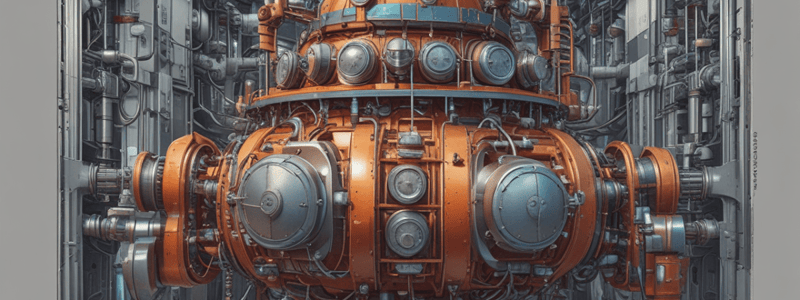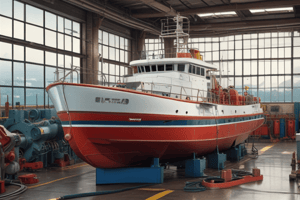Podcast
Questions and Answers
What needs to be done if there is no feedback on the blade position?
What needs to be done if there is no feedback on the blade position?
We need to keep a close eye on the blade position and manually maintain the position should they wander.
What action should be taken if the hydraulic system irreparably fails while on route and the blades assume zero pitch?
What action should be taken if the hydraulic system irreparably fails while on route and the blades assume zero pitch?
We need to rely on the backup system available, which may include a local hand pump to change pitch manually, a 'fail to full ahead' system where the blades move to the limit of forward travel by spring pressure, or accessing the end of the control rods in the engine room.
What is the purpose of the push-pull rod in the 'fail to full ahead' system?
What is the purpose of the push-pull rod in the 'fail to full ahead' system?
The push-pull rod is moved against a large spring in the hub, and relief of pressure against the piston allows the rod to return, so total failure of pressure results in the blades moving to the limit of forward travel by the spring pressure.
Where can the end of the control rods be accessed in the event of a hydraulic control failure within the engine room?
Where can the end of the control rods be accessed in the event of a hydraulic control failure within the engine room?
What are the three main options for backup systems in the event of a hydraulic system failure?
What are the three main options for backup systems in the event of a hydraulic system failure?
What is the purpose of the large spring in the 'fail to full ahead' system?
What is the purpose of the large spring in the 'fail to full ahead' system?
How can the blade position be manually maintained if there is no feedback on the blade position?
How can the blade position be manually maintained if there is no feedback on the blade position?
Explain the concept of 'resonance' in the context of a ship's components.
Explain the concept of 'resonance' in the context of a ship's components.
What is the purpose of using skew in propeller design?
What is the purpose of using skew in propeller design?
Define the term 'pitch' in the context of propeller design.
Define the term 'pitch' in the context of propeller design.
Explain the concept of 'slip' in relation to propeller performance.
Explain the concept of 'slip' in relation to propeller performance.
How does the rake of a propeller blade affect its performance?
How does the rake of a propeller blade affect its performance?
Describe the relationship between the pitch and the actual movement of a ship propelled by a propeller.
Describe the relationship between the pitch and the actual movement of a ship propelled by a propeller.
Explain the significance of the term 'cavitation' in the context of propeller design.
Explain the significance of the term 'cavitation' in the context of propeller design.
How does the 'yielding' nature of water affect the performance of a ship's propeller?
How does the 'yielding' nature of water affect the performance of a ship's propeller?
Discuss the role of propeller blade 'rake' in optimizing propeller efficiency.
Discuss the role of propeller blade 'rake' in optimizing propeller efficiency.
Explain how the concept of 'resonance' can impact the structural integrity of a ship's components.
Explain how the concept of 'resonance' can impact the structural integrity of a ship's components.
Explain the purpose of the stepped flange design in the CPP hub installation.
Explain the purpose of the stepped flange design in the CPP hub installation.
Describe the role of the fitted bolts and dowels in the CPP hub installation.
Describe the role of the fitted bolts and dowels in the CPP hub installation.
Explain the purpose of the pilgrim nut in propeller installation.
Explain the purpose of the pilgrim nut in propeller installation.
Describe the procedure for using the pilgrim nut to fit a keyless propeller.
Describe the procedure for using the pilgrim nut to fit a keyless propeller.
Other than imbalance, explain one reason for propeller-induced vibration related to the hull design.
Other than imbalance, explain one reason for propeller-induced vibration related to the hull design.
Explain how the propeller speed and engine vibrations can contribute to hull vibrations.
Explain how the propeller speed and engine vibrations can contribute to hull vibrations.
How does increasing the number of propeller blades affect propeller-induced vibrations?
How does increasing the number of propeller blades affect propeller-induced vibrations?
Describe the key components required for a transverse thruster arrangement with a controllable pitch propeller.
Describe the key components required for a transverse thruster arrangement with a controllable pitch propeller.
What is the purpose of ensuring the propeller pitch is at 'zero thrust' before starting a controllable pitch propeller?
What is the purpose of ensuring the propeller pitch is at 'zero thrust' before starting a controllable pitch propeller?
Why is there a higher risk of the propeller continuously rotating on a controllable pitch propeller system compared to a fixed pitch propeller?
Why is there a higher risk of the propeller continuously rotating on a controllable pitch propeller system compared to a fixed pitch propeller?
Explain the hazards associated with operating a thruster in areas with potential underwater obstructions.
Explain the hazards associated with operating a thruster in areas with potential underwater obstructions.
Describe the process for engaging a controllable pitch propeller thruster from a stopped condition.
Describe the process for engaging a controllable pitch propeller thruster from a stopped condition.
What additional safety considerations should be taken when operating transverse thrusters compared to a main propulsion system?
What additional safety considerations should be taken when operating transverse thrusters compared to a main propulsion system?
Explain how the controllable pitch feature of a propeller is utilized to optimize thruster performance and efficiency.
Explain how the controllable pitch feature of a propeller is utilized to optimize thruster performance and efficiency.
Describe the key components of an electrically driven tunnel thruster and how it functions.
Describe the key components of an electrically driven tunnel thruster and how it functions.
How would you maintain maneuvering control if the control system for a single electro/hydraulic controllable pitch propeller fails?
How would you maintain maneuvering control if the control system for a single electro/hydraulic controllable pitch propeller fails?
What action should be taken if the hydraulic system for a single electro/hydraulic controllable pitch propeller irreparably fails while en route, causing the blades to assume zero pitch?
What action should be taken if the hydraulic system for a single electro/hydraulic controllable pitch propeller irreparably fails while en route, causing the blades to assume zero pitch?
Explain the electrical demand and control requirements for an electrically driven tunnel thruster.
Explain the electrical demand and control requirements for an electrically driven tunnel thruster.
How would you simplify the sketch of an electrically driven tunnel thruster to illustrate its key components?
How would you simplify the sketch of an electrically driven tunnel thruster to illustrate its key components?
Describe the potential consequences of overspeeding the propeller shaft if the hydraulic system fails and the blades assume zero pitch.
Describe the potential consequences of overspeeding the propeller shaft if the hydraulic system fails and the blades assume zero pitch.
What are the advantages of using an electrically driven tunnel thruster over a traditional propeller system for maneuvering a vessel?
What are the advantages of using an electrically driven tunnel thruster over a traditional propeller system for maneuvering a vessel?
Flashcards are hidden until you start studying
Study Notes
Propeller Systems
- In case of hydraulic system failure, a backup system is required, with options including local hand pumps, fail-to-full-ahead, and manual control rods.
- Manual blade position maintenance is necessary to prevent wandering due to lack of feedback.
Propeller Terminology
- Skew: the "sweeping back" of a propeller blade, employed to reduce cavitation and noise.
- Rake: not explicitly defined, but related to propeller blade angle.
- Pitch: the distance a ship would move with one propeller revolution under ideal conditions; in reality, it's less due to water slip.
- Slip: the difference between ideal and actual propeller movement due to water yielding to the blades.
Transverse Thrusters
- Controllable pitch propellers (CPPs) require precautions, such as setting to "Zero Thrust" before starting the drive.
- Thrusters require clearing the surrounding area to prevent rope fouling.
Electrically Driven Tunnel Thrusters
- Consist of a single propeller and electric motor with speed and directional control.
- Require substantial electrical power and have a fixed blade design.
Controllable Pitch Propellers (CPPs)
- In case of control system failure, manual maintenance of blade position is necessary.
- Hydraulic system failure may require backup systems, such as local hand pumps or fail-to-full-ahead.
Propeller Fitting
- Pilgrim nuts are used to secure keyless propellers to the shaft.
- The pilgrim nut system involves hydraulic pressure to push the propeller onto the taper, ensuring correct fitting.
Propeller-Induced Vibration
- Reasons for vibration include: • Hull influence and tight clearance between propeller tip and hull underside. • Alignment of propeller speed with main engine vibrations, causing global or local vibrations.
Studying That Suits You
Use AI to generate personalized quizzes and flashcards to suit your learning preferences.




